OPEL COMBO 2010 Owners Manual
Manufacturer: OPEL, Model Year: 2010, Model line: COMBO, Model: OPEL COMBO 2010Pages: 212, PDF Size: 2.49 MB
Page 141 of 212
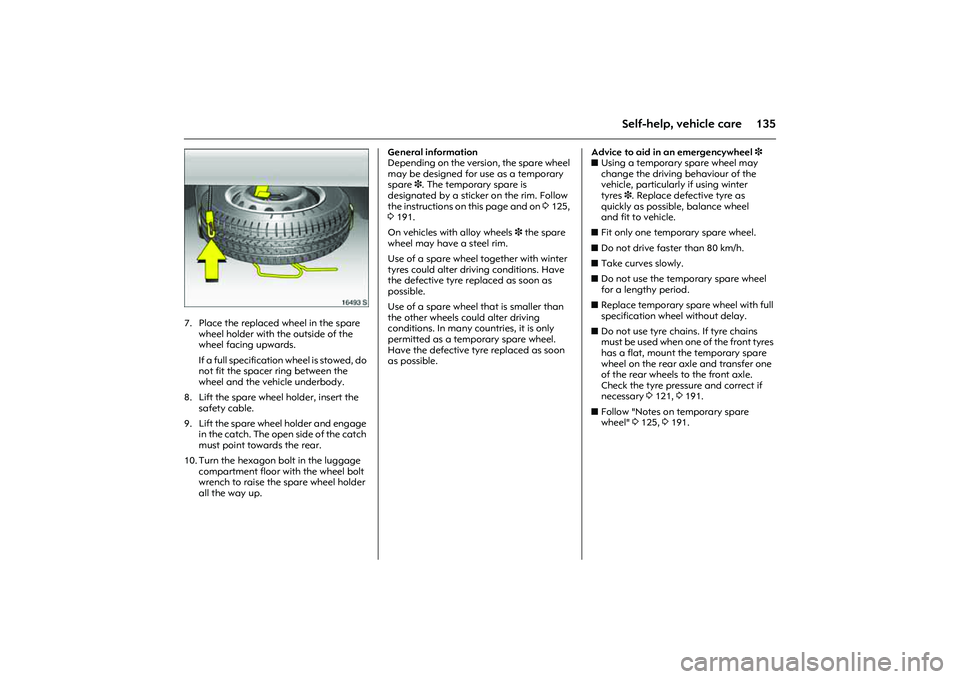
135
Self-help, vehicle care
Picture no: 16493s.tif
7. Place the replaced wheel in the spare
wheel holder with the outside of the
wheel facing upwards.
If a full specification wheel is stowed, do
not fit the spacer ring between the
wheel and the vehicle underbody.
8. Lift the spare wheel holder, insert the
safety cable.
9. Lift the spare wheel holder and engage
in the catch. The open side of the catch
must point towards the rear.
10. Turn the hexagon bolt in the luggage
compartment floor with the wheel bolt
wrench to raise the spare wheel holder
all the way up. General information
Depending on the version, the spare wheel
may be designed for use as a temporary
spare 3. The temporary spare is
designated by a sticker on the rim. Follow
the instructions on this page and on 3125,
3191.
On vehicles with alloy wheels 3 the spare
wheel may have a steel rim.
Use of a spare wheel together with winter
tyres could alter driving conditions. Have
the defective tyre replaced as soon as
possible.
Use of a spare wheel that is smaller than
the other wheels could alter driving
conditions. In many countries, it is only
permitted as a temporary spare wheel.
Have the defective tyre replaced as soon
as possible. Advice to aid in an emergencywheel 3
zUsing a temporary spare wheel may
change the driving behaviour of the
vehicle, particularly if using winter
tyres3. Replace defective tyre as
quickly as possible, balance wheel
and fit to vehicle.
zFit only one temporary spare wheel.
zDo not drive faster than 80 km/h.
zTake curves slowly.
zDo not use the temporary spare wheel
for a lengthy period.
zReplace temporary spare wheel with full
specification wheel without delay.
zDo not use tyre chains. If tyre chains
must be used when one of the front tyres
has a flat, mount the temporary spare
wheel on the rear axle and transfer one
of the rear wheels to the front axle.
Check the tyre pressure and correct if
necessary 3121, 3191.
zFollow "Notes on temporary spare
wheel" 3125, 3191.
Page 142 of 212
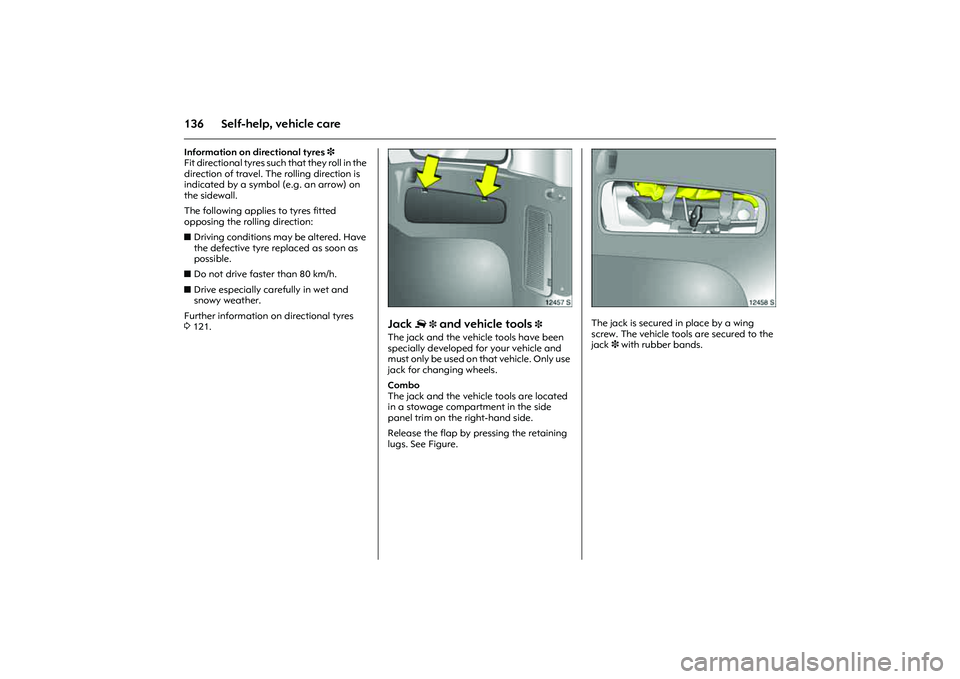
136 Self-help, vehicle careInformation on directional tyres 3
Fit directional tyres such that they roll in the
direction of travel. The rolling direction is
indicated by a symbol (e.g. an arrow) on
the sidewall.
The following applies to tyres fitted
opposing the rolling direction:
zDriving conditions may be altered. Have
the defective tyre replaced as soon as
possible.
zDo not drive faster than 80 km/h.
zDrive especially carefully in wet and
snowy weather.
Further information on directional tyres
3121.
Picture no: 2457s.tif
Jack
£
3 and vehicle tools
3
The jack and the vehicle tools have been
specially developed for your vehicle and
must only be used on that vehicle. Only use
jack for changing wheels.
Combo
The jack and the vehicle tools are located
in a stowage compartment in the side
panel trim on the right-hand side.
Release the flap by pressing the retaining
lugs. See Figure.
Picture no: 12458s.tif
The jack is secured in place by a wing
screw. The vehicle tools are secured to the
jack 3 with rubber bands.
Page 143 of 212
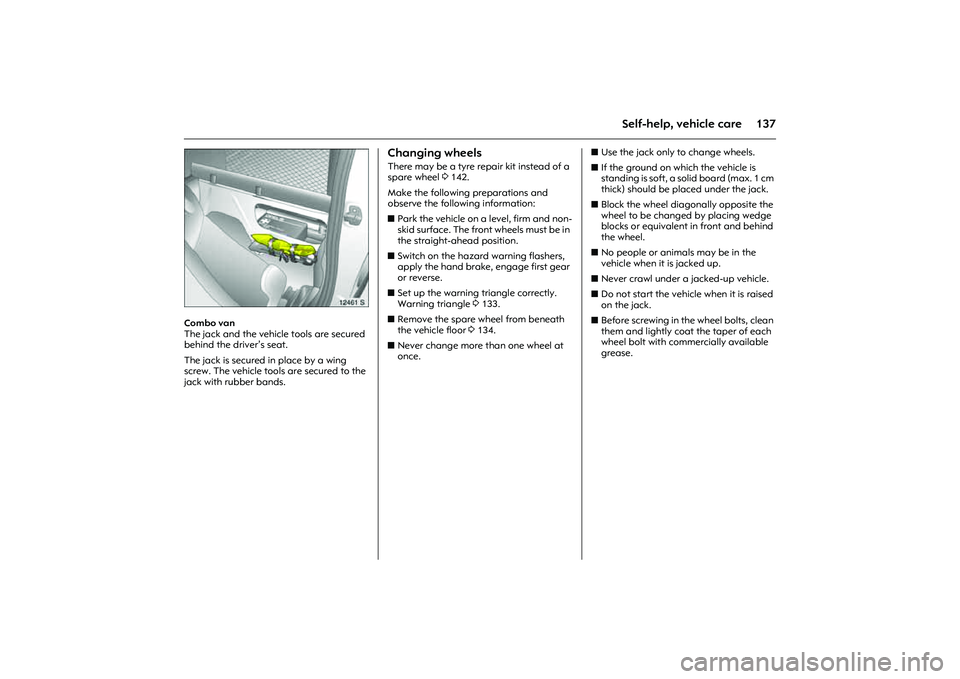
137
Self-help, vehicle care
Picture no: 12461s.tif
Combo van
The jack and the vehicle tools are secured
behind the driver’s seat.
The jack is secured in place by a wing
screw. The vehicle tools are secured to the
jack with rubber bands.
Changing wheels There may be a tyre repair kit instead of a
spare wheel 3142.
Make the following preparations and
observe the following information:
zPark the vehicle on a level, firm and non-
skid surface. The front wheels must be in
the straight-ahead position.
zSwitch on the hazard warning flashers,
apply the hand brake, engage first gear
or reverse.
zSet up the warning triangle correctly.
Warning triangle 3133.
zRemove the spare wheel from beneath
the vehicle floor 3134.
zNever change more than one wheel at
once. zUse the jack only to change wheels.
zIf the ground on which the vehicle is
standing is soft, a solid board (max. 1 cm
thick) should be placed under the jack.
zBlock the wheel diagonally opposite the
wheel to be changed by placing wedge
blocks or equivalent in front and behind
the wheel.
zNo people or animals may be in the
vehicle when it is jacked up.
zNever crawl under a jacked-up vehicle.
zDo not start the vehicle when it is raised
on the jack.
zBefore screwing in the wheel bolts, clean
them and lightly coat the taper of each
wheel bolt with commercially available
grease.
Page 144 of 212
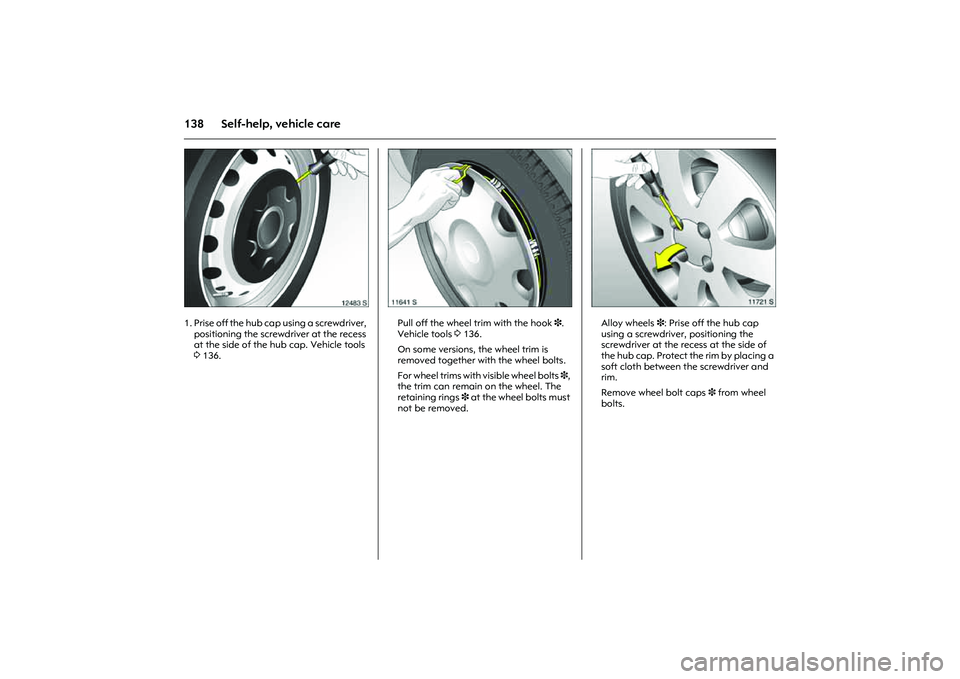
138 Self-help, vehicle care
Picture no: 12483s.tif
1. Prise off the hub cap using a screwdriver,
positioning the screwdriver at the recess
at the side of the hub cap. Vehicle tools
3136.
Picture no: 11641s.tif
Pull off the wheel trim with the hook 3.
Vehicle tools 3136.
On some versions, the wheel trim is
removed together with the wheel bolts.
For wheel trims with visible wheel bolts 3,
the trim can remain on the wheel. The
retaining rings 3 at the wheel bolts must
not be removed.
Picture no: 11721s.tif
Alloy wheels 3: Prise off the hub cap
using a screwdriver, positioning the
screwdriver at the recess at the side of
the hub cap. Protect the rim by placing a
soft cloth between the screwdriver and
rim.
Remove wheel bolt caps 3 from wheel
bolts.
Page 145 of 212
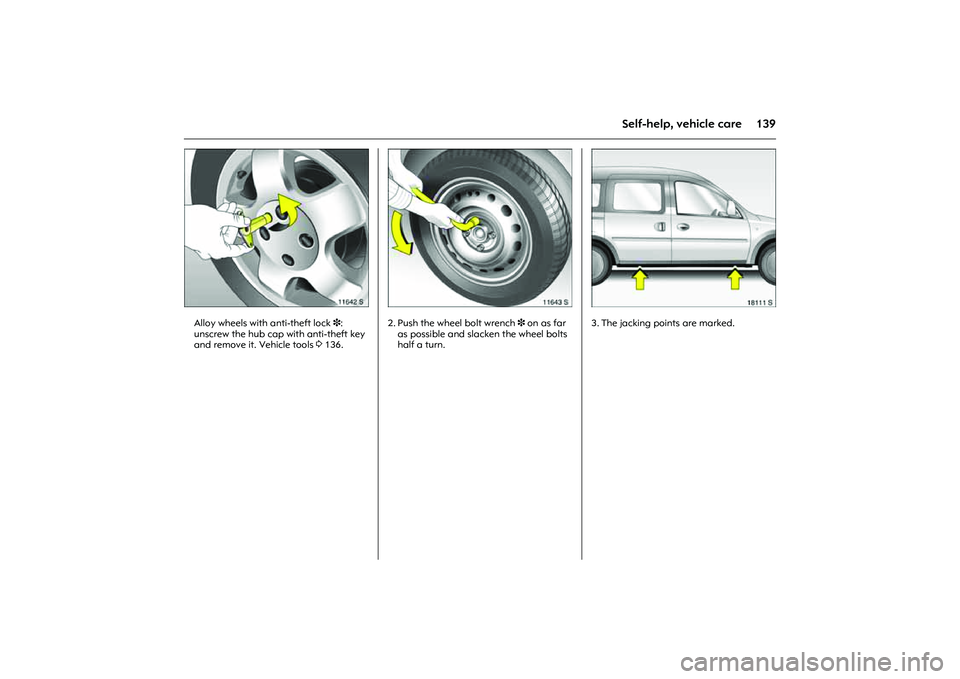
139
Self-help, vehicle care
Picture no: 11642s.tif
Alloy wheels with anti-theft lock3:
unscrew the hub cap with anti-theft key
and remove it. Vehicle tools 3136.
Picture no: 11643s.tif
2. Push the wheel bolt wrench 3 on as far
as possible and slacken the wheel bolts
half a turn.
Picture no: 18111s.tif
3. The jacking points are marked.
Page 146 of 212

140 Self-help, vehicle care
Picture no: 11645s.tif
4. Pre-adjust the jack 3 to the required
height. Position the jack arm in the front
or rear so that the jack claw (arrow in
picture) grips the vertical web in the
recess. Make sure that it is correctly
seated.
Picture no: 11646s.tif
The edge of the jack base must be
planted firmly and vertically in line with
the contact point.
Raise vehicle by turning crank handle.
If this is not the case, carefully lower the
vehicle immediately and reposition the
jack.5. Unscrew the wheel bolts.
On some versions, the wheel trim is
removed together with the wheel bolts.
If there are lock washers 3 on the wheel
bolts, these must not be removed.
6. Changing wheels. Notes on spare wheel
3134. Notes on temporary spare wheel
3125, 3135, 3191.
Page 147 of 212
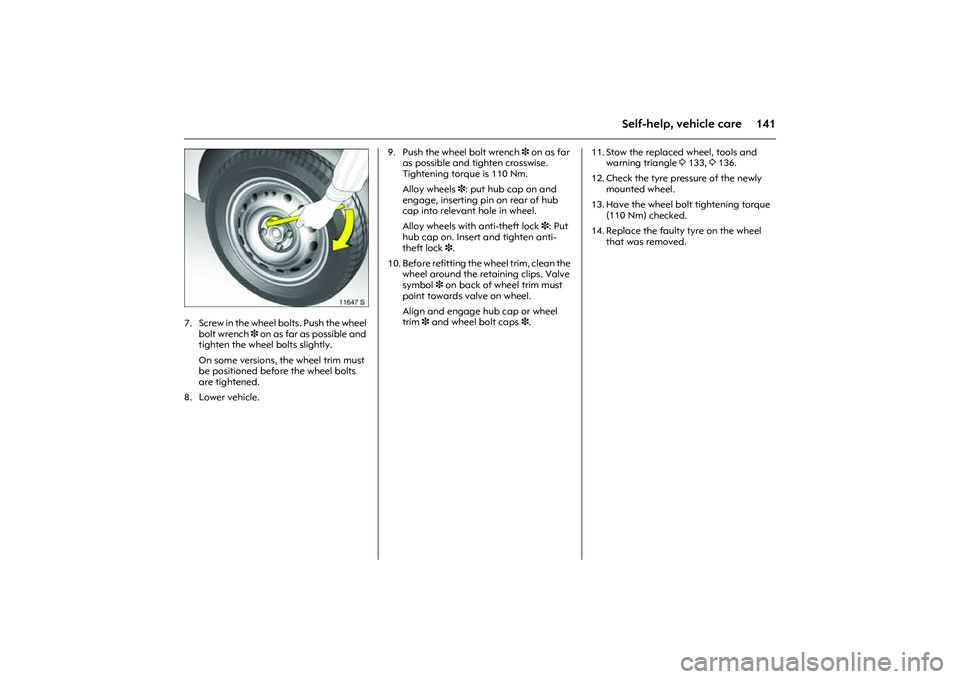
141
Self-help, vehicle care
Picture no: 11647s.tif
7. Screw in the wheel bolts. Push the wheel
bolt wrench 3 on as far as possible and
tighten the wheel bolts slightly.
On some versions, the wheel trim must
be positioned before the wheel bolts
are tightened.
8. Lower vehicle. 9. Push the wheel bolt wrench 3 on as far
as possible and tighten crosswise.
Tightening torque is 110 Nm.
Alloy wheels 3: put hub cap on and
engage, inserting pin on rear of hub
cap into relevant hole in wheel.
Alloy wheels with anti-theft lock3: Put
hub cap on. Insert and tighten anti-
theft lock3.
10. Before refitting the wheel trim, clean the
wheel around the retaining clips. Valve
symbol 3 on back of wheel trim must
point towards valve on wheel.
Align and engage hub cap or wheel
trim 3 and wheel bolt caps 3.11. Stow the replaced wheel, tools and
warning triangle 3133, 3136.
12. Check the tyre pressure of the newly
mounted wheel.
13. Have the wheel bolt tightening torque
(110 Nm) checked.
14. Replace the faulty tyre on the wheel
that was removed.
Page 148 of 212

142 Self-help, vehicle careTyre repair kit
3
Minor damage to the tyre tread or sidewall
can be repaired with the tyre repair kit.
Do not remove the foreign body from the
tyre.
T y r e d a m a g e e x c e e d i n g 4 m m o r t ha t i s o n
the rim cannot be repaired with the tyre
repair kit.
Important information 3145.
In the event of a flat tyre:
zSwitch on the hazard warning flashers,
apply the hand brake, engage first gear
or reverse.
zSet up the warning triangle correctly.
Warning triangle 3133.On the Combo, the tyre repair kit is located
behind a cover on the left in the side trim of
the luggage compartment. On the Combo
Van, it is located in a compartment behind
the driver’s seat.
To open the cover 3, press to release the
retaining lugs.
1. Remove bag containing tyre repair kit
from compartment. Carefully remove
parts from bag.
2. Remove the compressor.
Picture no: 13639T.tif
3. Remove the electrical connection
cable and air hose from the stowage
compartments on the underside of the
compressor.
9 Warning
Do not drive faster than 80 km/h.
Do not use the temporary spare wheel
for a lengthy period.
Steering and handling may be affected.
Page 149 of 212
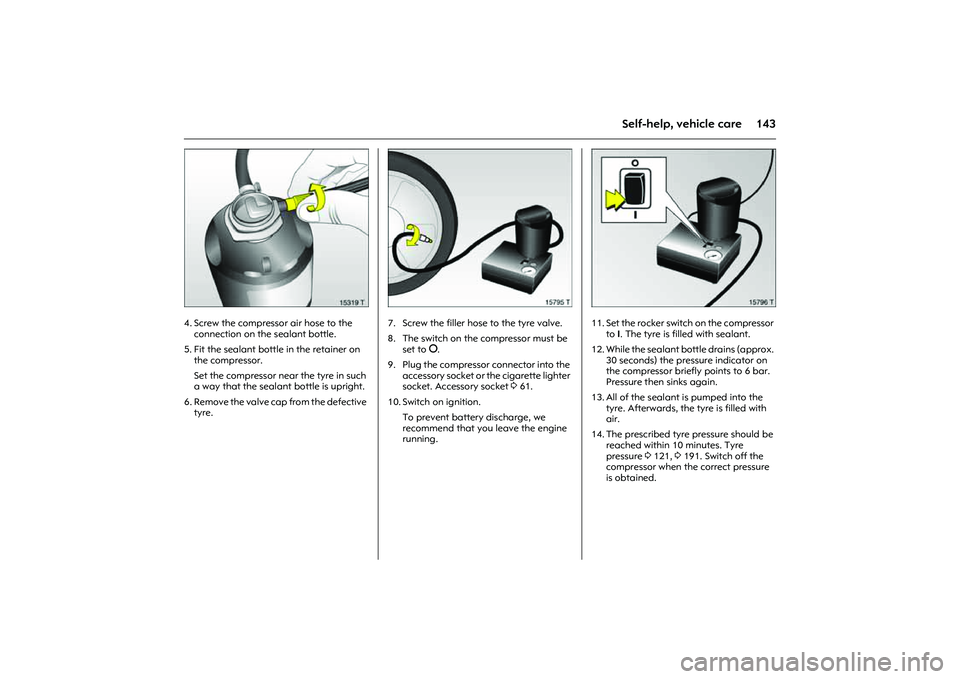
143
Self-help, vehicle care
Picture no: 15319t.tif
4. Screw the compressor air hose to the
connection on the sealant bottle.
5. Fit the sealant bottle in the retainer on
the compressor.
Set the compressor near the tyre in such
a way that the sealant bottle is upright.
6. Remove the valve cap from the defective
tyre.
Picture no: 15795t.tif
7. Screw the filler hose to the tyre valve.
8. The switch on the compressor must be
set to §.
9. Plug the compressor connector into the
accessory socket or the cigarette lighter
socket. Accessory socket 361.
10. Switch on ignition.
To prevent battery discharge, we
recommend that you leave the engine
running.
Picture no: 15796t.tif
11. Set the rocker switch on the compressor
to I. The tyre is filled with sealant.
12. While the sealant bottle drains (approx.
30 seconds) the pressure indicator on
the compressor briefly points to 6 bar.
Pressure then sinks again.
13. All of the sealant is pumped into the
tyre. Afterwards, the tyre is filled with
air.
14. The prescribed tyre pressure should be
reached within 10 minutes. Tyre
pressure 3121, 3191. Switch off the
compressor when the correct pressure
is obtained.
Page 150 of 212
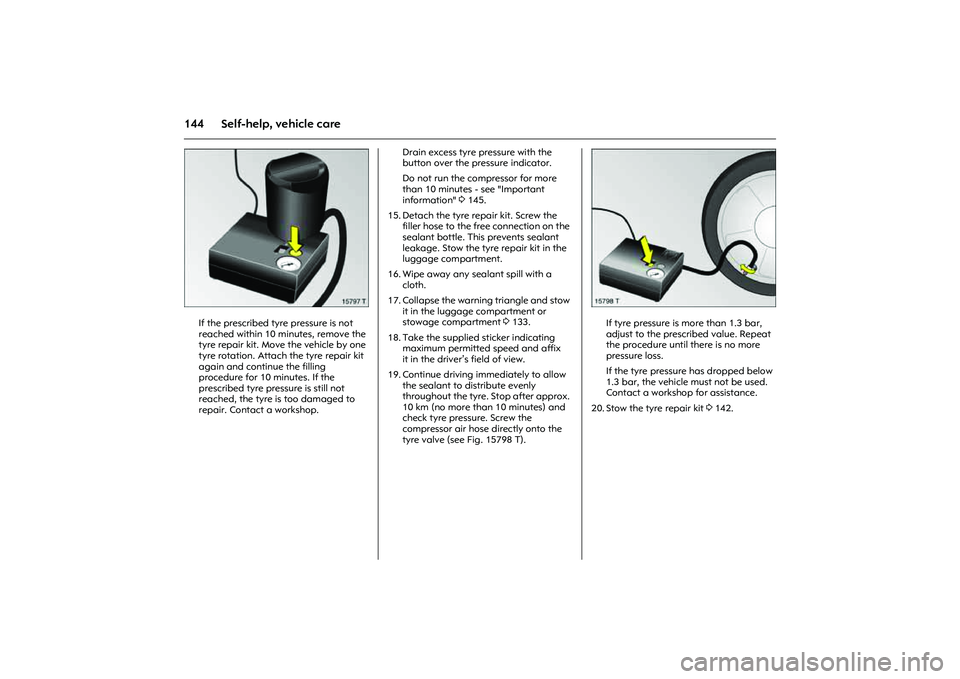
144 Self-help, vehicle care
Picture no: 15797t.tif
If the prescribed tyre pressure is not
reached within 10 minutes, remove the
tyre repair kit. Move the vehicle by one
tyre rotation. Attach the tyre repair kit
again and continue the filling
procedure for 10 minutes. If the
prescribed tyre pressure is still not
reached, the tyre is too damaged to
repair. Contact a workshop. Drain excess tyre pressure with the
button over the pressure indicator.
Do not run the compressor for more
than 10 minutes - see "Important
information" 3145.
15. Detach the tyre repair kit. Screw the
filler hose to the free connection on the
sealant bottle. This prevents sealant
leakage. Stow the tyre repair kit in the
luggage compartment.
16. Wipe away any sealant spill with a
cloth.
17. Collapse the warning triangle and stow
it in the luggage compartment or
stowage compartment 3133.
18. Take the supplied sticker indicating
maximum permitted speed and affix
it in the driver’s field of view.
19. Continue driving immediately to allow
the sealant to distribute evenly
throughout the tyre. Stop after approx.
10 km (no more than 10 minutes) and
check tyre pressure. Screw the
compressor air hose directly onto the
tyre valve (see Fig. 15798 T).
Picture no: 15798t.tif
If tyre pressure is more than 1.3 bar,
adjust to the prescribed value. Repeat
the procedure until there is no more
pressure loss.
If the tyre pressure has dropped below
1.3 bar, the vehicle must not be used.
Contact a workshop for assistance.
20. Stow the tyre repair kit 3142.